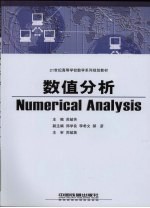

数值分析PDF电子书下载
- 电子书积分:12 积分如何计算积分?
- 作 者:苏岐芳主编
- 出 版 社:北京:中国铁道出版社
- 出版年份:2007
- ISBN:7113079873
- 页数:310 页
1 Error Analysis 1
1.1 Introduction 1
1.2 Sources of Errors 2
1.3 Errors and Significant Digits 4
1.4 Error Propagation 8
1.5 Qualitative Analysis and Control of Errors 10
1.5.1 Ill-condition Problem and Condition Number 10
1.5.2 The Stability of Algorithm 10
1.5.3 The Control of Errors 12
1.6 Computer Experiments 15
1.6.1 Functions Needed in The Experiments by Mathematica 15
1.6.2 Experiments by Mathematica 15
1.6.3 Functions Needed in The Experiments by Matlab 17
1.6.4 Experiments by Matlab 17
2 Interpolating 20
2.1 Introduction 21
2.2 Basic Concepts 22
2.3 Lagrange Interpolation 23
2.3.1 Linear and Parabolic Interpolation 23
2.3.2 Lagrange Interpolation Polynomial 26
2.3.3 Interpolation Remainder and Error Estimate 27
2.4 Divided-differences and Newton Interpolation 31
2.5 Differences and Newton Difference Formulae 35
2.5.1 Differences 35
2.5.2 Newton Difference Formulae 38
2.6 Hermite Interpolation 41
2.7 Piecewise Low Degree Interpolation 45
2.7.1 Ill-posed Properties of High Degree Interpolation 45
2.7.2 Piecewise Linear Interpolation 45
2.7.3 Piecewise Interpolation of Hermite with Degree Three 46
2.8 Cubic Spline Interpolation 48
2.8.1 Definition of Cubic Spline 48
2.8.2 The Construction of Cubic Spline 49
2.9 Computer Experiments 52
2.9.1 Functions Needed in The Experiments by Mathematica 52
2.9.2 Experiments by Mathematica 53
3 Best Approximation 63
3.1 Introduction 63
3.2 Norms 64
3.2.1 Vector Norms 64
3.2.2 Matrix Norms 69
3.3 Spectral Radius 71
3.4 Best Linear Approximation 75
3.4.1 Basic Concepts and Theories 75
3.4.2 Best Linear Approximation 76
3.5 Discrete Least Squares Approximation 78
3.6 Least Squares Approximation and Orthogonal Polynomials 83
3.7 Computer Experiments 89
3.7.1 Functions Needed in The Experiments by Mathematica 89
3.7.2 Experiments by Mathematica 90
3.7.3 Functions Needed in The Experiments by Matlab 96
3.7.4 Experiments by Matlab 96
4 Numerical Integration and Differentiation 99
4.1 Introduction 100
4.2 Interpolatory Quadratures 101
4.2.1 Interpolatory Quadratures 101
4.2.2 Degree of Accuracy 102
4.3 Newton-Cotes Quadrature Formula 103
4.4 Composite Quadrature Formula 109
4.4.1 Composite Trapezoidal Rule 109
4.4.2 Composite Simpson's Rule 110
4.5 Romberg Integration 111
4.5.1 Recursive Trapezoidal Rule 111
4.5.2 Romberg Algorithm 112
4.5.3 Richardson's Extrapolation 114
4.6 Gaussian Quadrature Formula 115
4.7 Numerical Differentiation 120
4.7.1 Numerical Differentiation 120
4.7.2 Differentiation Polynomial Interpolation 121
4.7.3 Richardson's Extrapolation 126
4.8 Computer Experiments 128
4.8.1 Functions Needed in The Experiments by Mathematica 128
4.8.2 Experiments by Mathematica 129
4.8.3 Experiments by Matlab 134
5 Solution of Nonlinear Equations 138
5.1 Introduction 138
5.2 Basic Theories 141
5.3 Bisection Method 142
5.4 Iterative Method and Its Convergence 144
5.4.1 Fixed Point and Iteration 144
5.4.2 Global Convergence 145
5.4.3 Local Convergence 148
5.4.4 Order ofConvergence 150
5.5 Accelerating Convergence 151
5.6 Newton's Method 153
5.6.1 Newton's Method and Its Convergence 153
5.6.2 Reduced Newton Method and Newton's Descent Method 155
5.6.3 The Case of Multiple Roots 156
5.7 Secant Method and Muller Method 158
5.7.1 Secant Method 158
5.7.2 Muller Method 159
5.8 Systems of Nonlinear Equations 160
5.9 Computer Experiments 163
5.9.1 Functions Needed in The Experiments by Mathematica 163
5.9.2 Experiments by Mathematica 163
5.9.3 Experiments by Matlab 168
6 Direct Methods for Solving Linear Systems 172
6.1 Introduction 173
6.2 Gaussian Elimination 174
6.2.1 Basic Gaussian Elimination 174
6.2.2 Triangular Decomposition 178
6.3 Gaussian Elimination with Column Pivoting 181
6.4 Methods of The Triangular Decomposition 183
6.4.1 The Direct Methods of The Triangular Decomposition 183
6.4.2 The Square Root Method 185
6.4.3 The Speedup Method 188
6.5 Analysis of Round-off Errors 191
6.5.1 Condition Number 191
6.5.2 Iterative Refinement 195
6.6 Computer Experiments 197
6.6.1 Functions Needed in The Experiments by Mathematica 197
6.6.2 Experiments by Mathematica 197
6.6.3 Functions Needed in The Experiments by Matlab 203
6.6.4 Experiments by Matlab 203
7 Iterative Techniques for Solving Linear Systems 209
7.1 Introduction 210
7.2 Basic Iterative Methods 212
7.2.1 Jacobi Method 213
7.2.2 Gauss-Seidel Method 215
7.2.3 SOR Method 216
7.3 Iterative Method Convergence 217
7.3.1 Basic Theorems 217
7.3.2 Some Special Systems of Equations 222
7.4 Computer Experiments 226
7.4.1 Functions Needed in The Experiments by Mathematica 226
7.4.2 Experiments by Mathematica 227
8 Numerical Solution of Ordinary Differential Equations 234
8.1 Introduction 234
8.2 The Existence and Uniqueness of Solutions 236
8.3 Taylor-Series Method 238
8.4 Euler's Method 240
8.5 Single-step Methods 243
8.5.1 Single-step Methods 243
8.5.2 Local Truncation Error 244
8.6 Runge-Kutta Methods 245
8.6.1 Second-Order Runge-Kutta Method 245
8.6.2 Fourth-Order Runge-Kutta Method 246
8.7 Multistep Methods 248
8.7.1 General Formulas of Multistep Methods 248
8.7.2 Adams Explicit and Implicit Formulas 249
8.8 Systems and Higher-Order Differential Equations 252
8.8.1 Vector Notation 253
8.8.2 Taylor-Series Method for Systems 255
8.8.3 Fourth-Order Runge-Kutta Formula for Systems 256
8.9 Computer Experiments 258
8.9.1 Functions Needed in The Experiments by Mathematica 258
8.9.2 Experiments by Mathematica 258
附录 266
附录A Mathematica基本操作 266
附录B Matlab基本操作 285
附录C Answers to Selected Problems 305
参考文献 310
- 《水面舰艇编队作战运筹分析》谭安胜著 2009
- 《分析化学》陈怀侠主编 2019
- 《影响葡萄和葡萄酒中酚类特征的因素分析》朱磊 2019
- 《FDS火灾数值模拟》李胜利,李孝斌编著 2019
- 《仪器分析技术 第2版》曹国庆 2018
- 《全国普通高等中医药院校药学类专业十三五规划教材 第二轮规划教材 分析化学实验 第2版》池玉梅 2018
- 《Power BI数据清洗与可视化交互式分析》陈剑 2020
- 《行测资料分析》李永新主编 2019
- 《药物分析》贡济宇主编 2017
- 《土壤环境监测前沿分析测试方法研究》中国环境监测总站编著 2018
- 《中国当代乡土小说文库 本乡本土》(中国)刘玉堂 2019
- 《异质性条件下技术创新最优市场结构研究 以中国高技术产业为例》千慧雄 2019
- 《中国铁路人 第三届现实主义网络文学征文大赛一等奖》恒传录著 2019
- 《莼江曲谱 2 中国昆曲博物馆藏稀见昆剧手抄曲谱汇编之一》郭腊梅主编;孙伊婷副主编;孙文明,孙伊婷编委;中国昆曲博物馆编 2018
- 《中国制造业绿色供应链发展研究报告》中国电子信息产业发展研究院 2019
- 《中国陈设艺术史》赵囡囡著 2019
- 《指向核心素养 北京十一学校名师教学设计 英语 七年级 上 配人教版》周志英总主编 2019
- 《《走近科学》精选丛书 中国UFO悬案调查》郭之文 2019
- 《清至民国中国西北戏剧经典唱段汇辑 第8卷》孔令纪 2018
- 《北京生态环境保护》《北京环境保护丛书》编委会编著 2018
